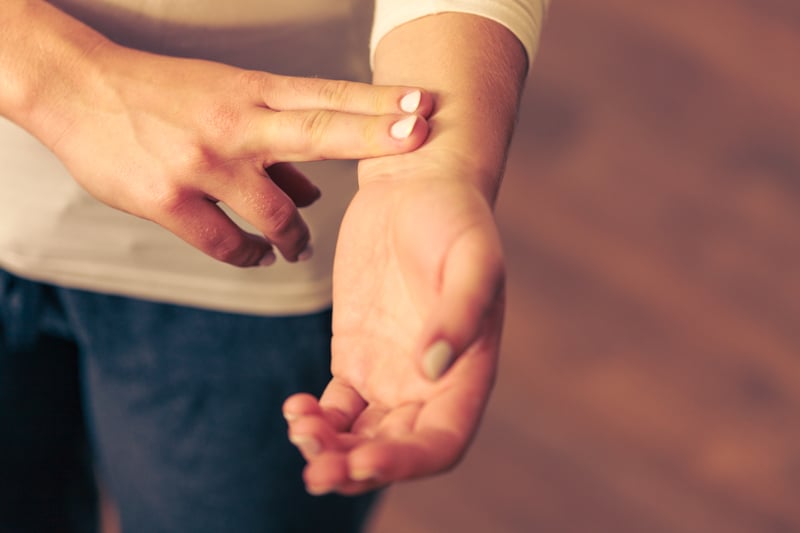What Your Resting Heart Rate Says About You

Is it possible to discover how healthy your heart is with just 2 fingers in only 30 seconds? That’s all it takes to measure your resting heart rate, and that simple number can provide important data on how healthy you are. Really! Your resting heart rate can reveal a lot about you and your health.
What is Your Resting Heart Rate?
Your resting heart rate is the number of times your heart beats per minute while you’re sitting or lying down resting. This number provides a general picture of how well the heart muscle functions (as long as you don’t have a diagnosed heart condition). It can also indicate how well your workouts are improving your heart health and help indicate if you may have a potential heart issue forming.
How to Measure Your Resting Heart Rate
While smartwatches of all kinds will monitor your average resting heart rate for you, you don’t need anything that fancy. It just takes a clock or stopwatch and two fingers.
Step 1: Make sure you’re sitting or lying down quietly and at rest (at least two hours after any exercise) before you begin. (Your heart rate goes up when you’re moving around, excited, or scared and drops if you’re resting, calm, and comfortable.)
Step 2: With your palm facing up, take the index and middle finger from the other hand, and place your fingers on the top of the thumb side of your wrist, right near where you would wear a watch (on your radial artery). You should be able to find your pulse. However, you can also place two fingers on the side of your neck (on your carotid artery), around one inch below your jawbone (give or take), if that’s easier for you.
Step 3: Now that you have found your pulse, count your pulse for 30 seconds using a clock on the wall, a stopwatch, or any other accurate timer.
Step 4: Once 30 seconds has ended, multiply the number of beats by two. That will tell you your resting heart rate.
Repeat this process at least a few times to get your average resting heart rate (and to ensure your first measurement was accurate). If you don’t mind math, you can also count heartbeats for just 10 seconds and multiply the number by 6 or for 15 seconds and multiply by 4.
What’s a Normal Resting Heart Rate?
There’s a lot of variation between individuals, and resting heart rate can also be impacted by medications, heart issues, and lifestyle factors. That said, “normal” resting heart rates for adults are generally between 60 and 100 beats per minute. 1 And heart rate can vary by as much as 70 beats per minute from one person to the next. 2 Children have higher resting heart rates than adults and teenagers.
Folks with a resting heart rate of 60 or below tend to be more physically fit and have better heart function due to their lifestyle choices (such as regular exercise, a quality diet, and staying hydrated). Folks who have a heart rate that’s higher than 100 beats per minute (known as tachycardia) may be experiencing excessive stress, drink too much caffeine, or are fighting an illness. If your symptoms also include shortness of breath, chest pain, or dizziness, make an appointment with your doc ASAP to help address any issues with your cardiovascular system.
Other factors that can affect resting heart rate include:
- Gender
- Stress and anxiety levels
- Sleep deprivation
- Medications, such as beta-blockers, allergy medications, or decongestants
- Caffeine consumption (from coffee, tea, soda, energy drinks, or medications)
- Disorders, such as anemia, hyper or hypothyroidism, 3 or diabetes
- Exercise
- Weight 4
- Fitness levels
- Inactivity
- Blood pressure
- Hot or humid weather conditions
- Body position
- Hydration levels
For those who don’t regularly exercise yet have a resting heart rate that’s below 50, it doesn’t necessarily mean you have a healthier heart. In fact, if you aren’t regularly exercising, a low resting heart rate (known as bradycardia) can indicate that you have a heart condition, and it’s time to visit your doctor. This is especially true if you have other symptoms like light-headedness. For example, a low resting heart rate that’s not explained by a heart-healthy exercise program could indicate issues with the electrical pathways in the heart muscle.
Likewise, a resting heart rate of 100 or above could indicate a heart issue, such as an infection, heart arrhythmia, or other issues. It can also be a sign that you’re at greater risk for premature death. Even a heart rate at the higher end of normal (95 to 100) has been linked with lower life expectancy. 1
However, it’s also important to know your own average resting heart rate, as what’s normal for one person may be high (or low) for others. So, noticing when your resting heart rate deviates from your normal could indicate something is amiss and it’s time to make an appointment with your doctor.
Other reasons to chat with your health-care professional about your resting heart rate include:
- If it’s consistently too fast or too slow
- If your heartbeats skip or are otherwise irregular
- If your heartbeats feel more like a vibration than a thump when you take your pulse
- If you experience heart palpitation; i.e., if feel your own heartbeat when you’re not taking your pulse and it feel unpleasant
- Annually, as it should be part of your general yearly checkup or physical.
SPECIAL OFFER: Ageless Turmeric Supports Healthy Inflammation Levels & Detoxification. Now Up to 71% Off.
How Much Does Exercise Improve Your Resting Heart Rate?
Regular exercise is the best and most reliable way to improve your resting heart rate. This is because regular exercise makes the heart muscle stronger, so it needs to beat less to pump blood efficiently. Generally speaking, the fitter you are, the lower your resting heart rate.
After starting a heart-healthy exercise program that includes cardio and weight training, you can expect your resting heart rate to improve by a beat or two per minute every week. This improvement can continue until your resting heart rate settles around 10 to 12 beats per minute less than when you started.
Workouts don’t have to be complicated or all that strenuous either. A brisk walking program has been found to decrease resting heart rate by 10 to 12 beats per minute. You can also choose swimming, cycling, rowing, dancing, circuit training, or any other activity that helps you reach your target aerobic heart rate (or between 70 and 80% of your max heart rate, which is ~220 minus your age).
For those who are most active, such as elite endurance athletes, a resting heart rate in the high 30s or low 40s isn’t unheard of.
Monitoring your resting heart rate when you start or change your fitness program can also help you gauge improvements and help you determine if you’re getting enough exercise or overdoing it. For example, if you’re overtraining and not giving your body time to rest and recover, you may see your resting heart rate go up rather than down.
Other steps you can take to improve your resting heart rate include:
- Stop smoking or vaping as nicotine is a stimulant that both increases heart rate and the risk of heart disease over time. 5
- Avoid binge drinking as having more than four (for women) or five (for men) drinks in a single day can tax the heart and cause it to beat more rapidly.
- Watch over-the-counter and prescription medications as some meds, such as those for colds or weight loss, can increase resting heart rate.
Why Lower Your Resting Heart Rate?
A heart rate that’s on the lower end has been associated with living longer in recent years. In general, lower is better. 6 However, rapid and unexplainable drops of more than 20 beats per minute could indicate a problem and should be brought to your doctor’s attention. It could, for example, indicate medical conditions such as thyroid disease or issues with the electrical conduction, especially if accompanied by other symptoms such as light-headedness or dizziness.
Tracking changes to your resting heart rate can also help detect heart rhythm disorders like atrial fibrillation.6 That said, you also don’t want to get overly focused on tracking your resting heart rate, which can lead to information overload and anxiety. This can lead to elevated heart rates and unnecessary visits to your doctor. So, avoid tracking individual numbers and instead focus on overall trends.
Remember, as well, that your heart rate can be affected by your age, medications you’re using, your stress levels, how well you’re sleeping, your current exercise program, diet, and hydration levels, as well as if you’re coming down with an illness, such as COVID-19.
Avoid comparing your heart rate with others as there can be a dramatic difference between your heart rate and your friend’s, co-worker’s, or partner’s. Instead, only compare your resting heart rate to your normal rate.
If you take that all into consideration, tracking your resting heart rate is one of the simplest ways to keep an eye on your general health and help you catch (and treat) problems early. Knowing your average resting heart rate can also help you determine your target heart rate when exercising, so you work smarter and get the most out of your activities.




 US Doctor: "Eating This Every Day Can Snap You Into Ketosis"
US Doctor: "Eating This Every Day Can Snap You Into Ketosis" 3 Key Nutrients to Help Lubricate Your "Tin Man" Joints
3 Key Nutrients to Help Lubricate Your "Tin Man" Joints AVOID Plant-Based Protein Powders (unless...)
AVOID Plant-Based Protein Powders (unless...)

